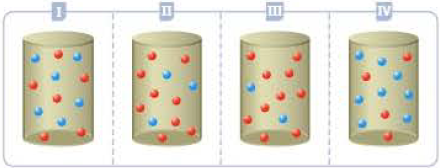
Consider the following hypothetical reactions. The equilibrium constants K given for each reaction are defined in terms of a concentration unit of molecules per liter.
Assume that the reactions have reached equilibrium. Match each of these reactions with one of the containers I to IV (each of which has a volume of 1 L). Identify the “color” of each molecule (for example, is A red or blue?).

Want to see the full answer?
Check out a sample textbook solution
Chapter 14 Solutions
Bundle: General Chemistry, Loose-leaf Version, 11th + OWLv2, 4 terms (24 months) Printed Access Card
- The table shows the tensile stress-strain values obtained for various hypothetical metals. Based on this, indicate which material will be the most ductile and which the most brittle. Material Yield strength Tensile strength Breaking strain Breaking strength Elastic modulus (MPa) (MPa) (MPa) (GPa) A 310 340 0.23 265 210 B 100 120 0.40 105 150 с 415 550 0.15 500 310 D 700 850 0.14 720 210 E - Non-effluence fracture 650 350arrow_forwardPlease correct answer and don't used hand raitingarrow_forwardDon't used hand raitingarrow_forward
- Consider the following Figure 2 and two atoms that are initially an infinite distance apart, x =00, at which point the potential energy of the system is U = 0. If they are brought together to x = x, the potential energy is related to the total force P by dU dx = P Given this, qualitatively sketch the variation of U with x. What happens at x=x? What is the significance of x = x, in terms of the potential energy? 0 P, Force 19 Attraction Total Repulsion x, Distance Figure 2. Variation with distance of the attractive, repulsive, and total forces between atoms. The slope dP/dx at the equilibrium spacing xe is proportional to the elastic modulus E; the stress σb, corresponding to the peak in total force, is the theoretical cohesive strength.arrow_forwardDenote the dipole for the indicated bonds in the following molecules. H3C ✓ CH3 B F-CCl 3 Br-Cl H3C Si(CH3)3 wwwwwww OH НО. HO HO OH vitamin C CH3arrow_forwardFor the SN2 reaction, draw the major organic product and select the correct (R) or (S) designation around the stereocenter carbon in the organic substrate and organic product. Include wedge-and-dash bonds and draw hydrogen on a stereocenter. Η 1 D EN Select Draw Templates More C H D N Erasearrow_forward
 Chemistry: Principles and PracticeChemistryISBN:9780534420123Author:Daniel L. Reger, Scott R. Goode, David W. Ball, Edward MercerPublisher:Cengage Learning
Chemistry: Principles and PracticeChemistryISBN:9780534420123Author:Daniel L. Reger, Scott R. Goode, David W. Ball, Edward MercerPublisher:Cengage Learning Chemistry: The Molecular ScienceChemistryISBN:9781285199047Author:John W. Moore, Conrad L. StanitskiPublisher:Cengage Learning
Chemistry: The Molecular ScienceChemistryISBN:9781285199047Author:John W. Moore, Conrad L. StanitskiPublisher:Cengage Learning Chemistry: Principles and ReactionsChemistryISBN:9781305079373Author:William L. Masterton, Cecile N. HurleyPublisher:Cengage Learning
Chemistry: Principles and ReactionsChemistryISBN:9781305079373Author:William L. Masterton, Cecile N. HurleyPublisher:Cengage Learning Chemistry & Chemical ReactivityChemistryISBN:9781337399074Author:John C. Kotz, Paul M. Treichel, John Townsend, David TreichelPublisher:Cengage Learning
Chemistry & Chemical ReactivityChemistryISBN:9781337399074Author:John C. Kotz, Paul M. Treichel, John Townsend, David TreichelPublisher:Cengage Learning Chemistry & Chemical ReactivityChemistryISBN:9781133949640Author:John C. Kotz, Paul M. Treichel, John Townsend, David TreichelPublisher:Cengage Learning
Chemistry & Chemical ReactivityChemistryISBN:9781133949640Author:John C. Kotz, Paul M. Treichel, John Townsend, David TreichelPublisher:Cengage Learning General Chemistry - Standalone book (MindTap Cour...ChemistryISBN:9781305580343Author:Steven D. Gammon, Ebbing, Darrell Ebbing, Steven D., Darrell; Gammon, Darrell Ebbing; Steven D. Gammon, Darrell D.; Gammon, Ebbing; Steven D. Gammon; DarrellPublisher:Cengage Learning
General Chemistry - Standalone book (MindTap Cour...ChemistryISBN:9781305580343Author:Steven D. Gammon, Ebbing, Darrell Ebbing, Steven D., Darrell; Gammon, Darrell Ebbing; Steven D. Gammon, Darrell D.; Gammon, Ebbing; Steven D. Gammon; DarrellPublisher:Cengage Learning





